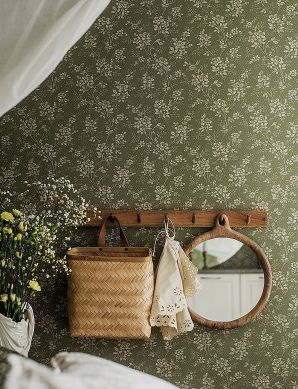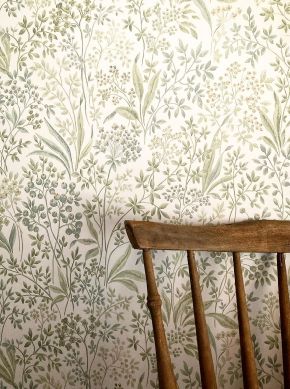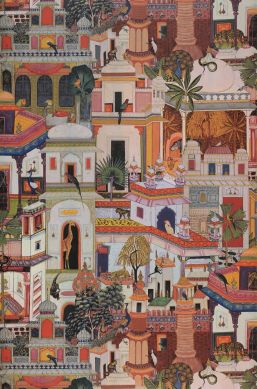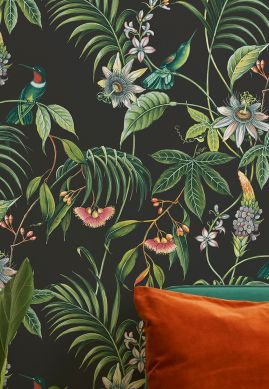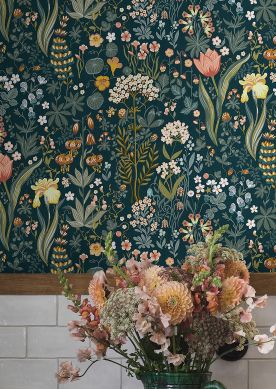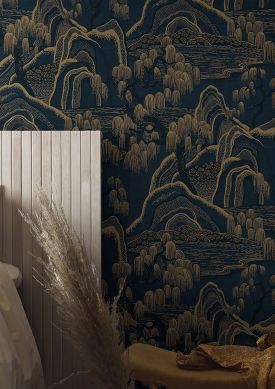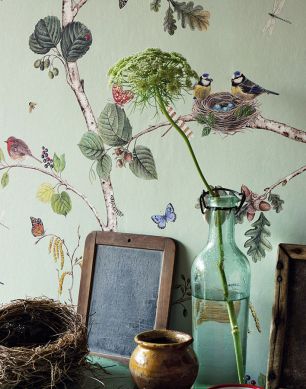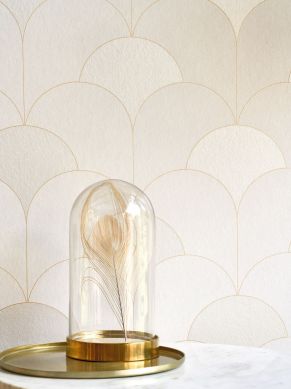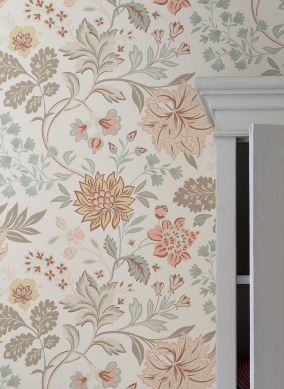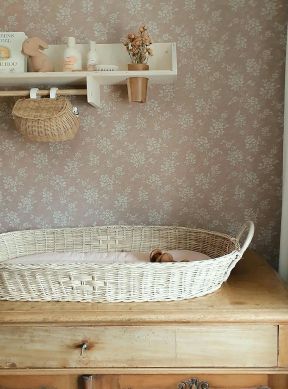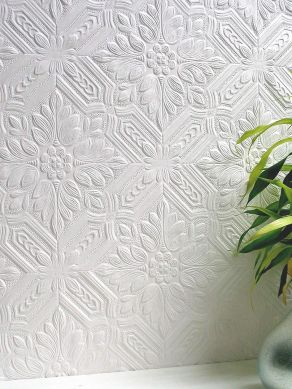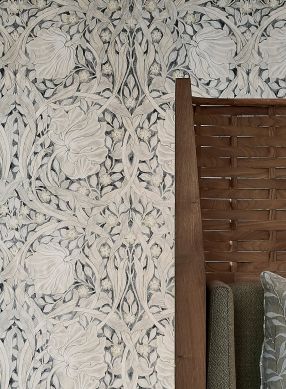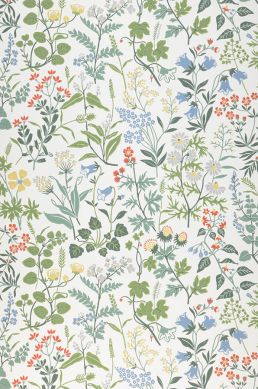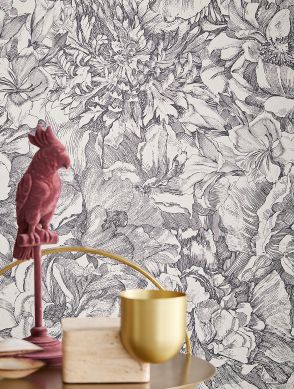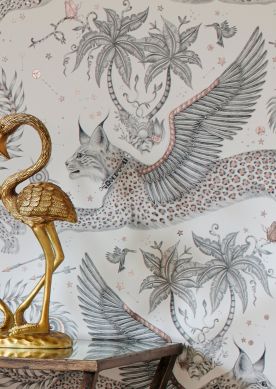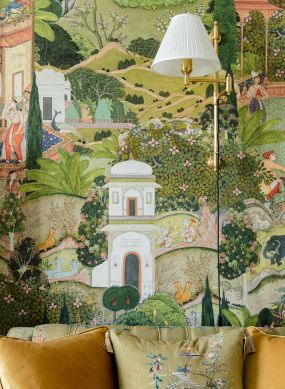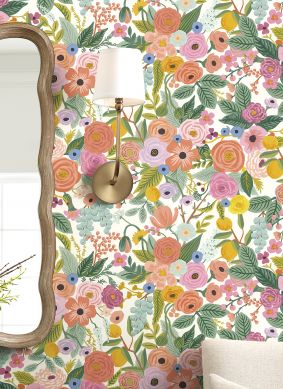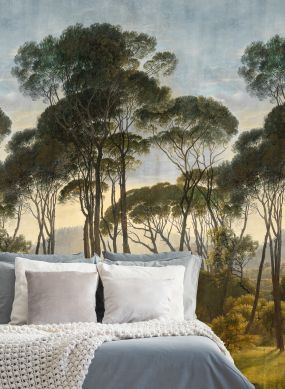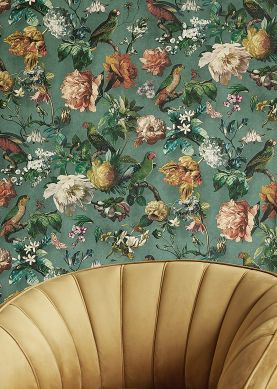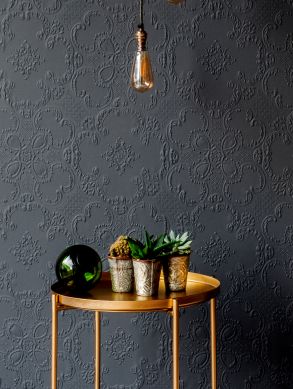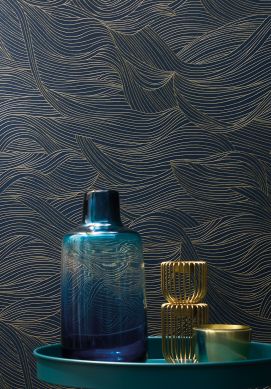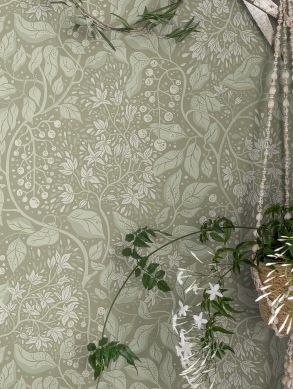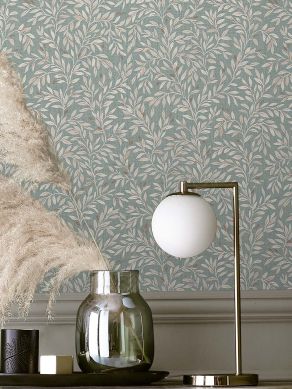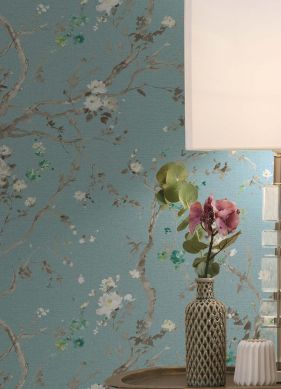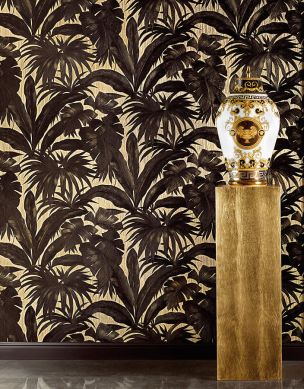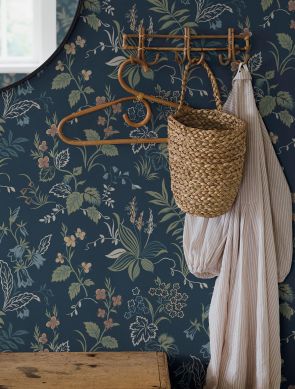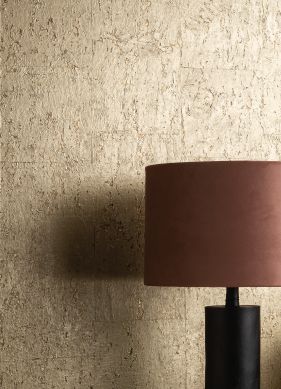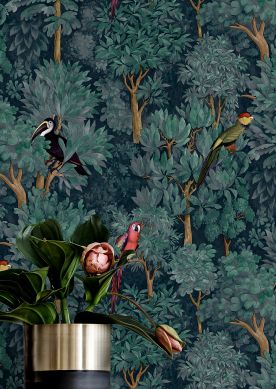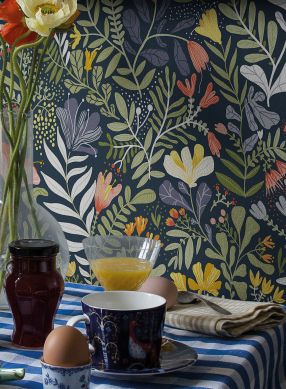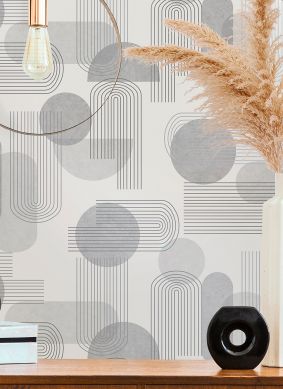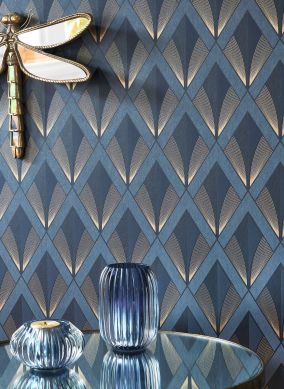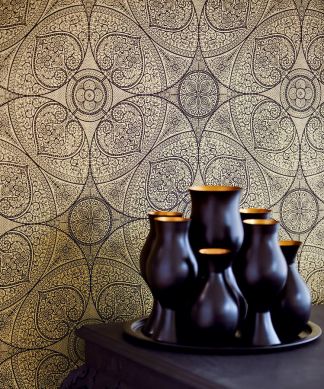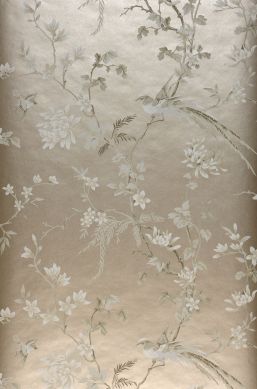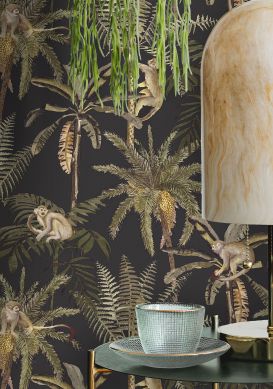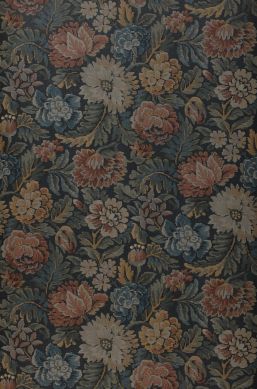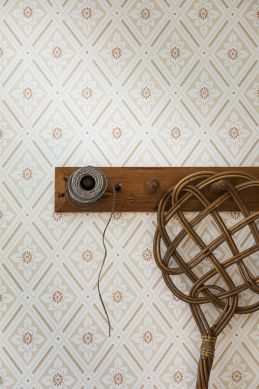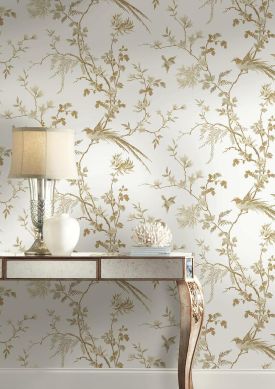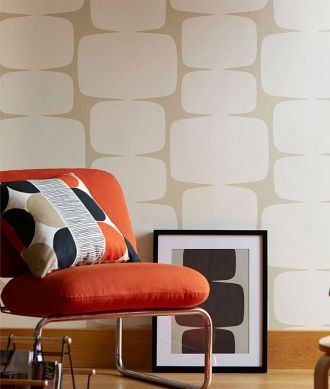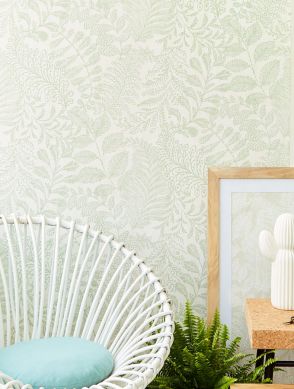Dining Room Wallpaper
Dining room wallpaper - The Guide
The dining room is a convivial space where the family meets to share meals. On festive days and for special occasions, beloved guests gather round the table. Today, eating is much more than just "food intake" - it is often a treasured time which should not be rushed.
Designing dining rooms with paint and wallpaper offers a plethora of options, often based on the huge variety nature provides us with. Elements associated with comfort, slowing down, cosiness, and memories also have a role to play. With its important tips and useful advice, our guide will help you find your perfect wallpaper choice. After all: Any food-related occasion should be a feast for the eyes, too.
Table of Contents
- What exactly is a dining area?
- How should one decorate a dining area?
- Wall paint or wallpaper for dining areas?
- Which colours are best for dining areas?
- How much wallpaper should be used in dining areas?
- Which type of wallpaper is best for dining areas?
- How can I find the best wallpaper for my dining area?
- What needs to be considered for public dining areas?
- Our tips: Current trends and tasty ideas for dining rooms
What exactly is a dining area?
A dining room is a separate room dedicated to eating meals with family and friends in a peaceful environment conducive to enjoyment and pleasure.
In terms of the history of dining rooms, they originated from the lifestyle and domestic culture of the aristocracy and the rich and powerful in medieval times and were exclusively found in castles and stately homes. The kitchen, where meals were prepared for the masters, was located in the basement, whereas the huge dining hall was found in the representative rooms. The centre piece of the dining hall was a very long and wide table which - depending on status and position of the owner - provided room for up to 100 people.
The dining room or hall served as a deliberate and clear separation between masters and servants, with the latter taking their meals in the kitchen. At the same time, it kept the heat and smells of the kitchen from the elegant surroundings of the dining hall, where culinary delights appeared as if by magic.
During the 19th and 20th century, the "privilege" of having the kitchen as a separate room from the dining room was introduced into the homes of the upper bourgeoisie. By the 1950s, it was an established part of modern domestic culture (as long as there was sufficient space). In the traditional sense, a dining room had to be separated from the kitchen and/or living room by a door. In modern, open-plan living spaces, this separation can be achieved by using different design wallpaper models.
The eye (and other senses) should all enjoy this room, so dining areas should be furnished and decorated in a functional as well as interesting way.
How should one decorate a dining area?
When selecting the most suitable wallpaper patterns and motifs, the size and layout of the space is as important as one's personal design preferences.
Small dining room
If the dining room is on the small side, choose light wallpaper colours (base and pattern). The pattern can be a bit experimental or even unusual, but it should be small-scale. Anything that adds subtle movement, e.g. clever geometric or floral designs, will distract from the limited space.
Large dining room
A large dining area can "cope" with large-scale, three-dimensional patterns and dark or intense colours representing extravagance and exclusivity. In terms of pattern motifs, anything goes in large rooms, just as long as there is consistency and a common theme. From large sea creatures to small fishes, from green Mediterranean oases to the olde-worlde charm of tea rooms, from modern loft styles with red brick motifs to graffiti art - whatever pleases the person designing the room and creates a balanced concept is very much in the realm of possibilities.
Wall paint or wallpaper for dining areas?
Wallpapers or paint, or a combination of both, are all good options for dining rooms. Generally speaking, a wallpapered feature wall is often enough to add an individual touch to the room.
Feature wall
A feature wall sets the scene for the chosen theme for the dining room (e.g. Mediterranean, modern, or rustic style), without being visually overwhelming. The wall behind or to the side of the dining table is best suited for a feature wall. The colour(s) of the remaining walls should match the feature wall.
Which colours are best for dining areas?
The colours used in the dining room should have an appetising effect and stimulate the taste buds. Good colour choices can also visually increase the space and make it appear much brighter.
Make a room appear more spacious
Hues of blue, green and yellow, or a balanced combination of them, as well as any number of pastels create a sense of open spaciousness even in the smallest dining room. The ceiling should be kept white in order to increase this effect. Our natural sense for colour has a preference for shades to turn lighter from bottom to top. A maximum of three colours which blend into each other in gently grading shades is often enough. Cool hues tend to be visually unobtrusive and create more space. Light colours can make narrow rooms appear wider. Nuances of white are ideal to make rooms look longer and add a sense of openness.
Make a room appear lighter
Matt and delicate colours with a large proportion of white reflect both natural and artificial light, so the dining room has a light and friendly feel. In order to emphasise the concept of pleasure and enjoyment, choose pastel sorbet colours, soft herb/plant nuances, or delicate cream, vanilla, and caramel hues.
Grey, green, blue, beige
Grey is an ideal colour partner to attenuate strong contrasts. This neutral colour makes stronger colours "pop", has a balancing impact and - in its lighter incarnations - can have a space-increasing effect. Lighter shades of blue and green add a sense of fresh zest and space to the room. These nuances should preferably be used in rooms with a good amount of daylight as they might feel a bit sterile otherwise. Beige has a warm, comforting effect and can be combined with more intense colours like red, orange, blue, purple, or green in the most harmonious manner.
How much wallpaper should be used in dining areas?
This decision should be based on the room's size, layout and natural light. For open plan living concepts, the wallpaper should serve as a tool to visually separate the kitchen and the living space.
Considering the impact of natural light
Colours, pattern types, effects - the appearance of the wallpaper is impacted by the light of sunlight in the room. A shiny, iridescent wallpaper model, for instance, can create glare and irritate the eye if hit by sunlight through a window. Depending on the location of the windows, the light can also create shadows on the wallpaper and interrupt the pattern in an unsightly manner. If you are planning to hang wallpaper on walls with windows or the opposite wall, you can test the potential effects by pinning up one to three lengths with drawing pins.
Separation: kitchen/living room
If the dining room has a passage to the kitchen, living room, or even both - a feature common in many contemporary interior design concepts - the area reserved for pleasant meals can be visually separated by clever use of wallpaper. The main issue to consider is that the wall design should be sufficiently different to that of the other rooms. For instance: if the eating area is adorned with a striking wallpaper model, the walls of the other rooms might simply be painted in order to create a distinct visual demarcation.
Which type of wallpaper is best for dining areas?
Washable wallpapers offer the obvious advantage of better cleanability. If the dining table is set at a distance from the wall, spongeable wallpaper models are also an option.
Washable (not absolutely necessary)
Washable wallpaper types come with the following classifications: washable, super-washable, scrubbable, and super-scrubbable. The stronger and denser the surface coating (to make it water-repellent), the more intensively it can be cleaned. Compared to kitchens, it is much less likely that food or ingredients will end up on the wall in dining rooms, so washable wallpaper isn't an absolute must.
Cleaning
Washable wallpaper models can be cleaned with lukewarm water and a soft sponge/cloth; for super-washable wallpaper models, soapy solution can be used, too. For scrubbable or super-scrubbable wallpaper, water-soluble and (some) fatty stains can be removed with a mild scouring agent and a soft brush.
Distance between table and wall
Ideally, i.e. in rooms that provide sufficient space, the dining table should be placed in the middle of the room so it is at the same distance to all four walls. In smaller dining rooms, the distance between table and wall should be at least 90 cm to avoid food splatter on the wallpaper.
How can I find the best wallpaper for my dining area?
As we all know, we all have different tastes - and this is true for wallpaper in individual dining rooms, too. Amongst the favourite styles for dining room design wallpaper are: rustic country house, modern New York kitchen, classic wallpaper patterns, and natural wood looks.
Country house (rustic)
Food is never better than when taken in the countryside. In addition, the rustic country house style reminds many of us of happy days spent with the grandparents, and the delicious aromas of freshly prepared meals and sweet cakes and biscuits. Examples of wallpaper patterns that fill the dining room with the unique flair of natural authenticity, comfort, cosiness and nostalgia, are geometric motifs (diamond shapes, stripes or plaids), lush field and meadow flowers, romantic landscape scenes, or brick or tile imitations.
Modern styles
A bright orange lobster on a turquoise background - what a mouth-watering scene! Modern, flamboyant, and unusual motif elements associated with the pleasures of food are as much part of the modern look as lush green floral scenes, reminiscent of the rainforest. Whatever tickles your fancy (and your tastebuds)!
Classic styles
Classic wallpaper patterns based on the eras of Baroque, Art Nouveau, and Art Deco, add glamour and elegance to dining rooms with an emphasis on sophistication and extravagance. They also provide a touch of the sought-after luxurious castle or mansion atmosphere around the table. Combined with striking modern colours, they create visual fireworks for the senses.
Wood imitation styles
Warm, comfortable, authentic - wood is the natural material most likely to turn even a little snack into a comforting, pleasurable experience. Whether you are after the romantic mountain cabin look with thick planks, or a maritime style with wood weathered by the sea air - wood imitation wallpaper makes food taste twice as good.
What needs to be considered for public dining areas?
Public refectories need to appeal to various target groups, from children to students, adults, or senior citizens. The most important element of any design concept is to create an inviting, appetising and relaxing effect.
Canteen (Companies)
Lunch-breaks should be enjoyed in a light, friendly, and relaxing ambience. The colours yellow, orange, and red are top of the list, but refreshing shades of green, light chocolate, coffee, and cream are also great options. Patterns and motifs associated with food and drink are obviously very suitable, as long as they aren't too overpowering. However, too many, or large-scale, motifs can be too distracting.
Cafeteria (University)
Bright colours are a good choice for a university's cafeteria. The emphasis should be on light and fresh hues. Artistic pattern motifs, perhaps with an experimental or unusual touch, but still loosely connected with the theme of food, are always a hit with students. Graffiti styles are also suitable.
Kindergarten/School
Kindergartens and schools often consider the children's natural curiosity and interest when it comes to food. In this context, colours have a huge role to play. Green, yellow, red, and blue reflect the colours of healthy fruit and vegetables and are thus an appetising choice in dining rooms for kids and teenagers. In terms of patterns, less is more, as children are easily distracted by too much visual stimulation. The best motifs are those that depict healthy food choices.
Our tips: Current trends and tasty ideas for dining rooms
- A long dining room wall benefits from imaginative sceneries. These could be in the shape of stunning green pattern landscapes with animals and flowers, arty geometric shapes, or abstract designs.
- Photographs add to the cosy, intimate family atmosphere, which makes this room so special. Find the required frames in various sizes and styles in some stunning picture-frame-themed wallpapers.
- A small dining area in the kitchen or living room appears larger if the adjacent wall is adorned with a contrasting eye-catching wallpaper.
- How about some lush floral patterns for the ceiling?


